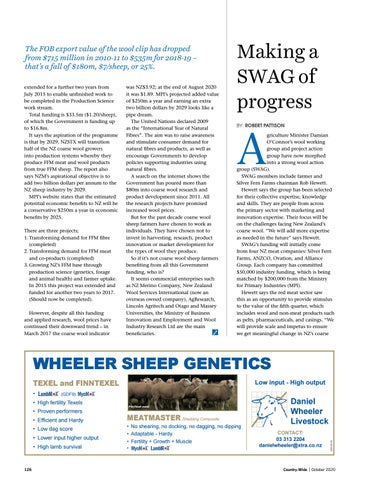The FOB export value of the wool clip has dropped from $715 million in 2010-11 to $535m for 2018-19 – that’s a fall of $180m, $7/sheep, or 25%. extended for a further two years from July 2015 to enable unfinished work to be completed in the Production Science work stream. Total funding is $33.5m ($1.20/sheep), of which the Government is funding up to $16.8m. It says the aspiration of the programme is that by 2029, NZSTX will transition half of the NZ coarse wool growers into production systems whereby they produce FFM meat and wool products from true FFM sheep. The report also says NZM’s aspirational objective is to add two billion dollars per annum to the NZ sheep industry by 2029. MPI’s website states that the estimated potential economic benefits to NZ will be a conservative $250m a year in economic benefits by 2025. There are three projects; 1. Transforming demand for FFM fibre (completed) 2. Transforming demand for FFM meat and co-products (completed) 3. Growing NZ’s FFM base through production science (genetics, forage and animal health) and farmer uptake. In 2015 this project was extended and funded for another two years to 2017. (Should now be completed). However, despite all this funding and applied research, wool prices have continued their downward trend – in March 2017 the coarse wool indicator
was NZ$3.92; at the end of August 2020 it was $1.89. MPI’s projected added value of $250m a year and earning an extra two billion dollars by 2029 looks like a pipe dream. The United Nations declared 2009 as the “International Year of Natural Fibres”. The aim was to raise awareness and stimulate consumer demand for natural fibres and products, as well as encourage Governments to develop policies supporting industries using natural fibres. A search on the internet shows the Government has poured more than $80m into coarse wool research and product development since 2011. All the research projects have promised increased wool prices. But for the past decade coarse wool sheep farmers have chosen to work as individuals. They have chosen not to invest in harvesting, research, product innovation or market development for the types of wool they produce. So if it’s not coarse wool sheep farmers benefiting from all this Government funding, who is? It seems commercial enterprises such as NZ Merino Company, New Zealand Wool Services International (now an overseas owned company), AgResearch, Lincoln Agritech and Otago and Massey Universities, the Ministry of Business Innovation and Employment and Wool Industry Research Ltd are the main beneficiaries.
Making a SWAG of progress BY: ROBERT PATTISON
A
griculture Minister Damian O’Connor’s wool working group and project action group have now morphed into a strong wool action group (SWAG). SWAG members include farmer and Silver Fern Farms chairman Rob Hewett. Hewett says the group has been selected for their collective expertise, knowledge and skills. They are people from across the primary sector with marketing and innovation expertise. Their focus will be on the challenges facing New Zealand’s coarse wool. “We will add more expertise as needed in the future” says Hewett. SWAG’s funding will initially come from four NZ meat companies: Silver Fern Farms, ANZCO, Ovation, and Alliance Group. Each company has committed $50,000 industry funding, which is being matched by $200,000 from the Ministry for Primary Industries (MPI). Hewett says the red meat sector saw this as an opportunity to provide stimulus to the value of the fifth quarter, which includes wool and non-meat products such as pelts, pharmaceuticals, and casings. “We will provide scale and impetus to ensure we get meaningful change in NZ’s coarse
WHEELER SHEEP GENETICS WHEELER SHEEP GENETICS WHEELER SHEEP GENETICS Very low input-high output
Very low input-high output
TEXEL and FINNTEXEL TEXEL and FINNTEXEL TEXEL and FINNTEXEL •• LambM (GDF9)X (GDF9) X (GDF9) • LambM
Low input - High output
High•fertility fertility Texels Daniel High HighTexels fertility Texels FinnTexel ewes FinnTexel ewes Proven performers Proven performers • Proven performers Wheeler MEATMASTER Efficient and Hardy MEATMASTER Shedding Composite MEATMASTER • Efficient and Hardy Shedding Composite Efficient and Hardy Livestock Selected for short tails Shedding •shearing, No shearing, no Composite docking, no dagging, no dipping • No no docking, • Selected for short tails Low score and dag low dag score, noVery low input-high output low input-high • Very No shearing, nooutput docking, CONTACT: no •dagging, no-dipping Adaptable Hardy and low dag score, no• Adaptable • Lower input higher output docking needed 03 313 2204 Hardy no dagging, no dipping TEXEL and FINNTEXEL TEXEL and FINNTEXEL • Fertility + Growth + Muscle danielwheeler@xtra.co.nz docking needed Lower input Higher • Fertility + Growth + Muscle • Adaptable Hardy •• High lamb survival • LambM X (GDF9) • LambM X •(GDF9)• output • Lower input Higher + Growth High fertility Texels + Muscle • High fertility Texels • •Fertility FinnTexel ewes FinnTexel ewes • output • Proven performers • Proven performers CONTACT: Daniel• Efficient and Hardy 03 313 MEATMASTER • Efficient and Hardy MEATMASTER 126 Country-Wide October 2020 2204 0094604©
WHEELER WHEELER SHEEP GENETICS SHEEP GENETICS
CONTACT: Shedding Composite Wheeler for short tails • Selected for short tails • Selected danielwheeler@xtra.co.nz 41©
•• •• • • • •
Shedding Composite
